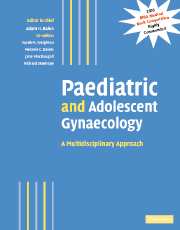Book contents
- Frontmatter
- Contents
- Contributors
- Preface
- Part I Normal development
- Part II Management of developmental abnormalities of the genital tract
- Part III Management of specific disorders
- 18 Disorders of growth and puberty
- 19 Turner's syndrome
- 20 Androgen insensitivity syndromes
- 21 Rokitansky syndrome and other Müllerian anomalies
- 22 The XY female
- 23 The gynaecology of the major genitourinary anomalies
- 24 Congenital adrenal hyperplasia
- 25 Long-term sequelae of genital surgery
- 26 Amenorrhoea
- 27 The polycystic ovary syndrome and adolescent women
- 28 Menstrual disorders in adolescent girls
- 29 Pelvic pain, ovarian cysts and endometriosis in adolescent girls
- 30 Premature ovarian failure and ovarian ageing
- 31 Gynaecological cancers in childhood
- 32 Late reproductive sequelae of treatment for childhood cancer
- 33 Preservation of fertility before cancer therapy
- 34 The management of infertility with surrogacy and egg donation
- 35 Dermatological conditions of the female genitalia
- 36 Vaginal discharge
- 37 Psychological gender development in individuals born with ambiguous genitalia
- 38 Eating disorders in adolescence
- 39 Nutritional amenorrhoea: long-term sequelae
- 40 How to set up a service: how to teach and train
- Index
- Plate section
- References
26 - Amenorrhoea
from Part III - Management of specific disorders
Published online by Cambridge University Press: 04 May 2010
- Frontmatter
- Contents
- Contributors
- Preface
- Part I Normal development
- Part II Management of developmental abnormalities of the genital tract
- Part III Management of specific disorders
- 18 Disorders of growth and puberty
- 19 Turner's syndrome
- 20 Androgen insensitivity syndromes
- 21 Rokitansky syndrome and other Müllerian anomalies
- 22 The XY female
- 23 The gynaecology of the major genitourinary anomalies
- 24 Congenital adrenal hyperplasia
- 25 Long-term sequelae of genital surgery
- 26 Amenorrhoea
- 27 The polycystic ovary syndrome and adolescent women
- 28 Menstrual disorders in adolescent girls
- 29 Pelvic pain, ovarian cysts and endometriosis in adolescent girls
- 30 Premature ovarian failure and ovarian ageing
- 31 Gynaecological cancers in childhood
- 32 Late reproductive sequelae of treatment for childhood cancer
- 33 Preservation of fertility before cancer therapy
- 34 The management of infertility with surrogacy and egg donation
- 35 Dermatological conditions of the female genitalia
- 36 Vaginal discharge
- 37 Psychological gender development in individuals born with ambiguous genitalia
- 38 Eating disorders in adolescence
- 39 Nutritional amenorrhoea: long-term sequelae
- 40 How to set up a service: how to teach and train
- Index
- Plate section
- References
Summary
Introduction
Amenorrhoea is the absence of menstruation, either temporarily or permanently. It may occur as a normal physiological condition, such as before puberty, during pregnancy, lactation or the menopause, or as a feature of a systemic or gynaecological disorder.
Primary amenorrhoea
The failure to menstruate by the age of 16 years in the presence of normal secondary sexual development, or 14 years in the absence of secondary sexual characteristics, warrants investigation. This distinction helps to differentiate reproductive tract anomalies from gonadal quiescence and gonadal failure (see earlier chapters). Primary amenorrhoea may be a result of congenital abnormalities in the development of ovaries, genital tract or external genitalia (see Chs. 20-24) or a disturbance of the normal endocrinological events of puberty (Ch. 18). Most of the causes of secondary amenorrhoea can also cause primary amenorrhoea if they occur before the menarche. Delayed puberty is often constitutional, but it is important to exclude primary ovarian failure or hypothalamic/pituitary dysfunction. Overall, it is estimated that endocrine disorders account for approximately 40% of primary amenorrhoea, the remaining 60% being the result of developmental abnormalities (Table 26.1).
Chapters 19 and 20–24 describe the causes of primary amenorrhoea other than those described below under secondary amenorrhoea. Many of these conditions will have presented either at birth or during childhood. Management should be in a specialized clinic that can provide a multidisciplinary approach to care.
- Type
- Chapter
- Information
- Paediatric and Adolescent GynaecologyA Multidisciplinary Approach, pp. 334 - 341Publisher: Cambridge University PressPrint publication year: 2004



